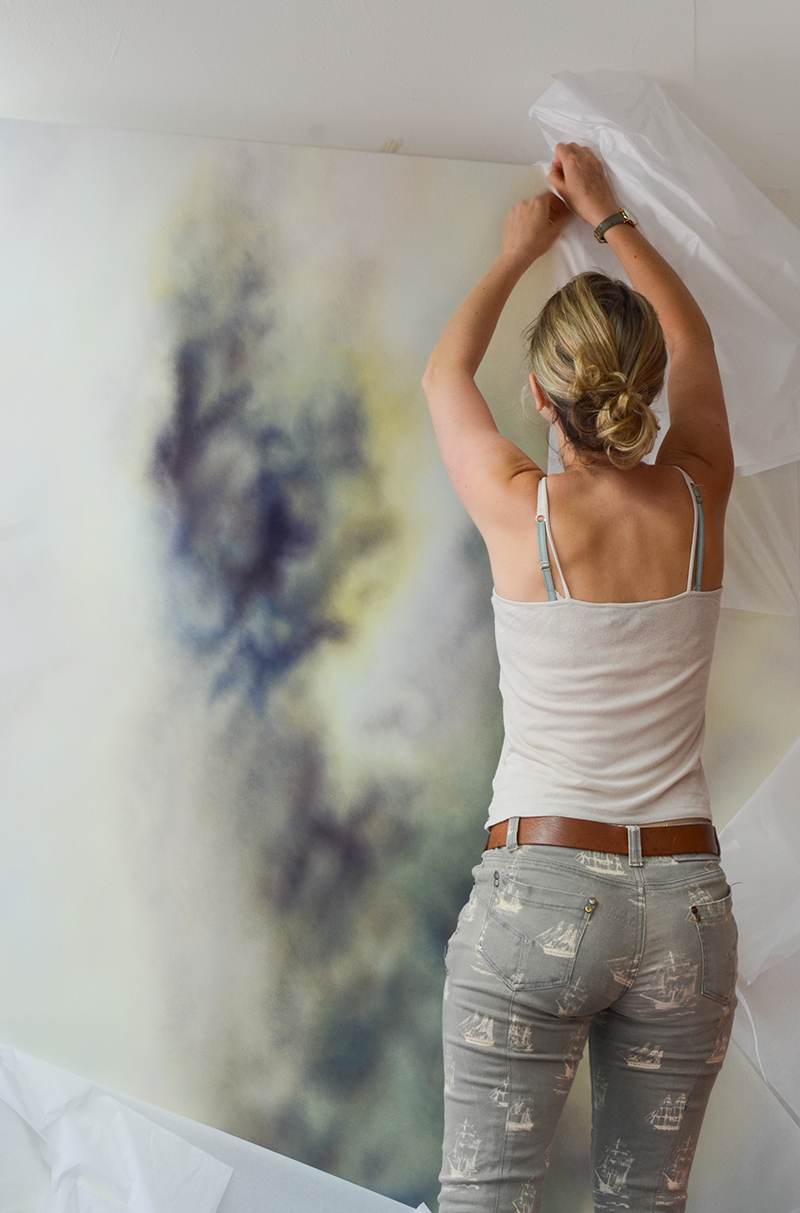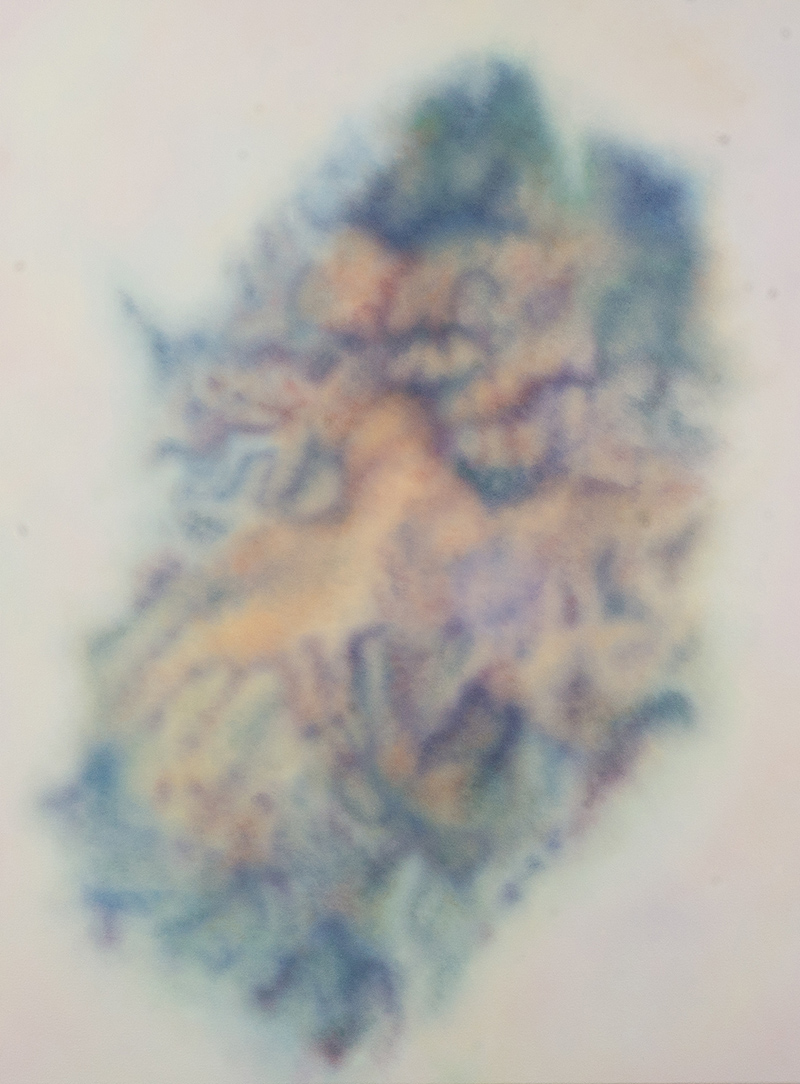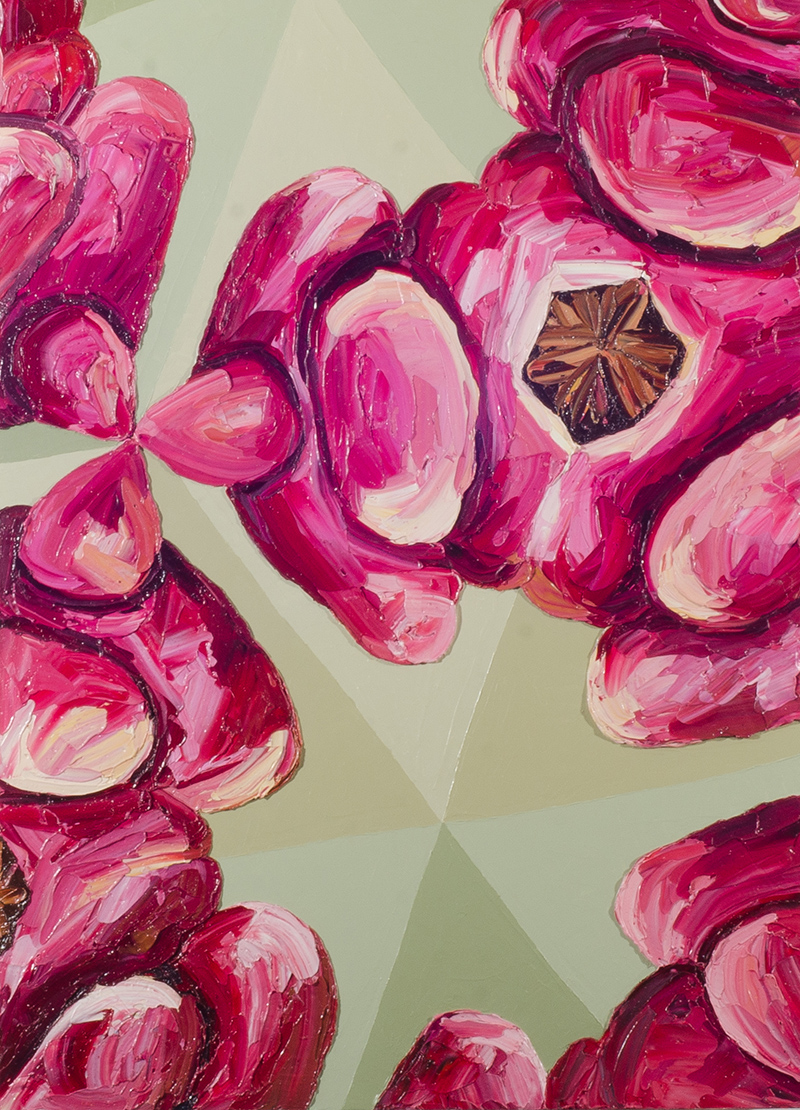I’m inspired by many things – the lived experience of being in a body, and a female one at that, feminism, biology, looking down a microscope, anatomy, Julia Kristeva’s book The Powers of Horror, the abject, Darren Aronofsky’s film Requiem for a Dream, bodily grossness, disease, blood, injury, beauty in things normally viewed as disgusting or taboo, and trying to wrap my head around death.
Damaris Athene is wary of commercial influence and saleability creeping into her work, as she explores materials and shifts her focus more towards feminism and the digital world.

Take us to the beginning of your journey in art.
I was always creative throughout my childhood, but I originally wanted to be a doctor. Gradually I became more and more interested in art. I realised that what I liked the most in biology was drawing the diagrams.
After school I went to do a foundation in art and design at Falmouth University, Cornwall, England. That opened my eyes to the wide range of things I could do. The art I had been taught at school was all about representation. I then went on to study at Camberwell College of Arts in London and graduated in 2015.
Tell us about the evolution of your practice over the years.
My practice has always been connected to the body and I started out working figuratively. I’ve always loved painting but, in my foundation course, I focussed more on photography, using models to create staged dramatic scenarios, and started my bachelor’s degree at Camberwell in photography.
After a term I switched to painting as I was becoming increasingly frustrated with the barrier the camera was creating between me and the art I was making. I did a lot of traditional film photography and working in the darkroom but that wasn’t hands-on enough for me. I missed molding materials with my hands. My painting practice at the university focussed on using ink. After graduation, I worked as a painting assistant for Science Ltd. and was using oil 40 hours a week. I hadn’t used it since school and fell in love with it all over again. I have been focussing on oil ever since, using it in different ways. Now my practice is starting to expand to contain more printmaking, such as screen-printing, and sculpture. I’m excited to use the new techniques that I’ve recently learnt.

3 Trauma V
What were your biggest lessons and hurdles along the way? Which is the most memorable moment?
I think the biggest thing I have learnt is not to overthink things and to reach a conclusion through the process of making. At the university I would think past an idea – poking holes in it and thinking it over too much, rather than trying it and seeing if it worked. I have learnt to experiment more and not worry about the outcome and I have gained confidence over the years. I have also learnt the hard way to be more selective about the opportunities I apply for, not only as many cost money to enter or participate in, but I have ended up in group exhibitions where the standard of work was disappointing. I was in an exhibition last year in Moscow and my work was damaged. I know now to be more vigilant and inspect the work before taking it away. A painful lesson!
My most memorable moment would be being selected for the Beep Painting Prize. At the private view, I was really impressed by the work selected and was so proud to be showing alongside people whose work I looked up to.
What inspires you? Take us through your process and references.
I’m inspired by many things – the lived experience of being in a body, and a female one at that, feminism, biology, looking down a microscope, anatomy, Julia Kristeva’s book The Powers of Horror, the abject, Darren Aronofsky’s film Requiem for a Dream, bodily grossness, disease, blood, injury, beauty in things normally viewed as disgusting or taboo, and trying to wrap my head around death. Recently, I have been getting more and more interested in how the digital world affects our bodily reality. I take inspiration from photo editing apps to change appearance, things seen online, the ways women’s bodies are portrayed and expected to be altered, and how digital manipulation of images changes the way we look at ourselves.
The teaching and workshops I do often trigger new ideas. It’s such a pleasure to be able to test out new materials and ideas in a pressure-free way. I often find this feeds back into my practice.

What is the primary role of an artist? How do you describe yourself in the context of challenging people’s perspectives via your work?
I see the role of art as making people think and look at something in a new or different way. It’s an opportunity to gain a new perspective and experience visual, contemplative or sensory pleasure. Art can show you something you wouldn’t normally see or consider. It gives you permission to look and examine, something that’s becoming even more imperative in our fast-paced digital world.
I hope to challenge perspectives with my work and to provoke discussions about uncomfortable subjects.
How do you balance art and life?
With great difficulty! It’s hard to balance the paid work I do, teaching art one-on-one and facilitating art workshops for galleries, with time in the studio. I constantly need to adjust and reassess. It’s hard to make a barrier between the different work and jobs I do, and to not let everything bleed into one, including time that I keep for relaxation. I’m not very good at leaving any time for rest and end up working most of the time. It is a constant struggle. Recently, I have had a break from my practice as I needed to do more paid work, started a new job, and moved house. Now I’m settling into my new routine and need to be mindful not to take on too much freelance work that eats into studio time, as I work 15 hours a week.
I don’t worry about selling as I don’t want commercial influence on my work. It’s hard enough trying to wrestle with making work you believe to be good, without adding something that is saleable into the mix. I’m able to avoid it by earning money through teaching.
How do you deal with the conceptual difficulty and uncertainty of creating work?
I’m gradually getting more and more confident, but of course I have frequent times of doubt. I find it best to follow a thread and keep ploughing forward. I always have lots of ideas fizzing in my head and it’s often difficult to know which avenue to go down as there are too many options. My recent break from making work has made me really eager to get back to the studio. Before that I was struggling with how to take my practice forward as I was reassessing absolutely everything. Now I feel ready to get back to it.
![]()
Pixelate Me II
How does your audience interact and react to the work?
Often, I’m not there when people are looking at my work. The few times when I have been, I have had very interesting conversations with people. I remember especially the conversations sparked by my Lovely in Her Bones series, which depicts cancer tumours, where people would open up about their experiences with cancer. Cheer Up Love, my solo show at Peterhouse Cambridge University, contained re-makes of female nude old master paintings with male bodies instead of female ones. I had some engaging conversations about how shocking it was to see a male body in these contorted positions.
What are you looking for when you look at other artists’ work? Which shows, performances and experiences have shaped your creative process? Who are your maestros?
I’m not normally looking for anything in particular but, often, I am more engaged with work that works on a visual as well as conceptual level. I’m a very visual person. A work often stays with me if I have had a bodily interaction with it. I find that I can get a lot of inspiration from an exhibition, even if I don’t particularly like the work.
There are so many exhibitions that have influenced me that it’s very difficult to narrow it down. One show that does stand out would be Berlinde de Bruyckere’s solo show Suture at the Leopold Museum in Vienna. I was blown away by her haunting sculptures! Francis Bacon has always been a firm favourite of mine. I recently discovered the work of Rachel de Joode. I could go on.
What is that one thing you wished people would ask you but never do?
I would love to be asked to transform a space into a large immersive installation and to have months to do it.

The Pieces of My Spirit Strewn I
How do you feel about commissions?
I’ve found that commissions can be problematic as often neither party is fully pleased. I tend to avoid them if I can.
What are you working on now? What’s coming next season?
This is a transitional stage in my practice as I’m starting to include different materials and shift the focus more towards feminism and the digital world. Recently I showed some screen-prints at Woolwich Contemporary Print Fair, but I haven’t got any future exhibition dates set yet. However, I will be showing in a group show at Motion Sickness Project Space in Cambridge sometime next year but the details aren’t decided yet.
I’m also excited to develop my research on digital dysmorphia and to experiment with fabric sculptures, digital prints, installations and the hair I’ve been collecting for the past year! I want to expand painting to different media and supports, and can’t wait to play around.











Add Comment